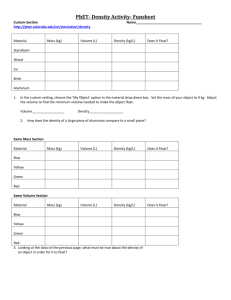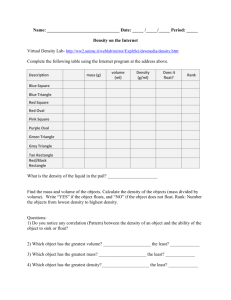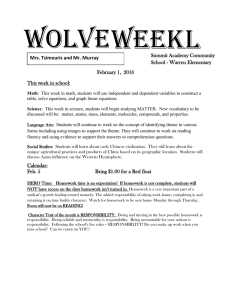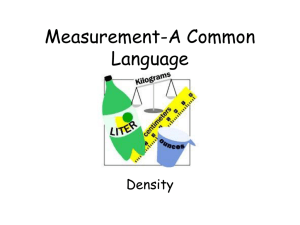TIME-SCALED DIAGRAM: Explained Free float
advertisement
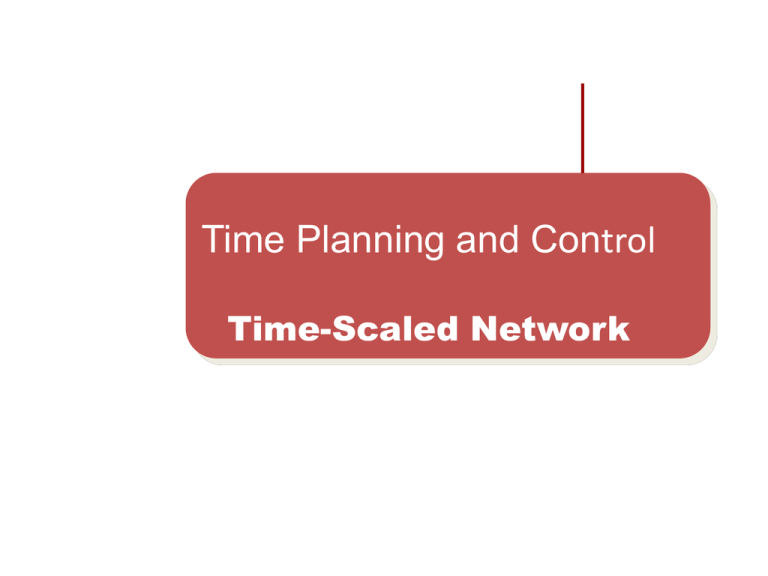
Time Planning and Control Time-Scaled Network Processes of Time Planning and Control 1. Visualize and define the activities. 2. Sequence the activities (Job Logic). 3. Estimate the activity duration. 4. Schedule of the project or phase. 5. Allocate and balance resources. 6. Compare target, planned and actual dates and update as necessary. 7. Control the time schedule with respect to changes. TIME-SCALED DIAGRAM The original project network is not plotted to a time scale. When drawing a time-scaled diagram, two time scales can be used: one in terms of working days and the other as calendar dates. Each activity is shown as a one dimensional line rather than as a two dimensional box. The horizontal length is equal to its estimated time duration (beginning at its ES and ending with its EF values). Example 1 The following activity list represents the job logic and the durations of activities for a small engineering project. Draw a time- scaled network for the project, determine project time and calculate the activities float times. Activity E B C G F A H D I J Depends on B, C A A E C, D None E, F A F G, H, I Duration (day) 2 3 4 3 5 2 2 5 4 2 Example 1 Activity E B C G F A H D I J Time-scaled Diagram E B Depends on B, C A A E C, D None E, F A F G, H, I Duration (day) 2 3 4 3 5 2 2 5 4 2 G H C D A 1 2 3 4 F 5 6 7 8 9 10 11 12 13 14 15 Project completion time = 18 working days Critical Path: A, D, F, I, J. Activity Total float Free float A 0 0 B 6 1 C 1 0 D 0 0 E 5 0 F 0 0 J I G 5 5 H 2 2 I 0 0 J 0 0 16 17 18 TIME-SCALED DIAGRAM: Explained Vertical solid (dashed) lines indicate sequential dependence of one activity on another. In effect, time-scaled networks are merely extensions of bar charts. When an activity has an early finish time that precedes the earliest start of activities following, the time interval between the two is the free float of the activity. Float times are shown as horizontal dashed lines. TIME-SCALED DIAGRAM: Explained Free float (activity float) is the amount of time that an activity’s completion time may be delayed without affecting the earliest start of succeeding activity. Total float (path float) is the amount of time that an activity’s completion may be delayed without extending project completion time. Total float (path float) is the amount of time that an activity’s completion may be delayed without affecting the earliest start of any activity on the network critical path. TIME-SCALED DIAGRAM: Explained Activity float (free float) is “owned” by an individual activity, whereas path float (total float) is shared by all activities along a slack path. Total path float time for activity (i-j) is the total float associated with a path. TIME-SCALED DIAGRAM: Explained Advantages of Time-scaled Diagram Very suitable device for checking daily project needs of different resources, and for the advance detection of conflicting demands among activities for the same resource. Useful for project financial management applications. Disadvantages of Time-scaled Diagram Because it is drawn by manual drafting methods, the level of effort needed to modify and update them is very large. Dependencies among activities are not always so obvious as they are on the activity on node network. Example2: TSN A market survey The following activity list represents the job logic and the durations of activities for a market survey project. Draw a time-scaled network for the project, determine project time and calculate the activities float times. Activity Description predecessors Duration, week A Plan survey — 1 B Hire personnel A 1 C Design questionnaire A 3 D Train personnel B, C 2 E Select samples of customers C 1 F Print questionnaire C 1 G Conduct survey D,E,F 3 H Analyze results G 2 Activity Example 2 Time-scaled Diagram Description predecessors Duration, week A Plan survey — 1 B Hire personnel A 1 C Design questionnaire A 3 D Train personnel B, C 2 E Select samples of customers C 1 F Print questionnaire C 1 G Conduct survey D,E,F 3 H Analyze results G 2 F E A C D G H B 1 2 3 4 5 6 7 8 9 Project completion time = 11 weeks Critical Path: A, C, D, G, H. Activity Total float Free float A 0 0 B 2 2 C 0 0 D 0 0 E 1 1 F 1 1 G 0 0 H 0 0 10 11 12


